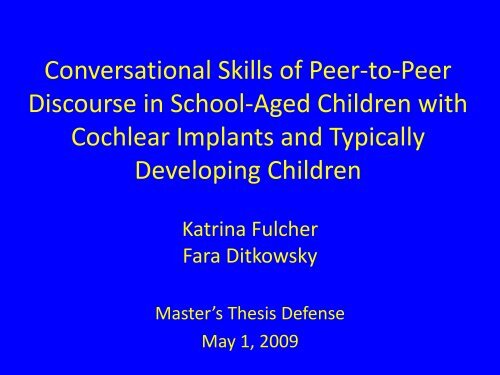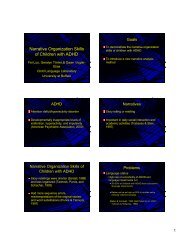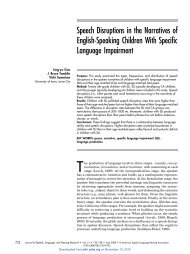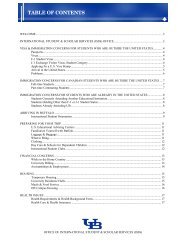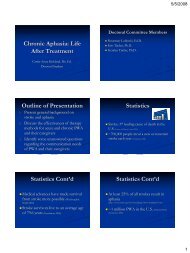Ditkowsky Fulcher Research Day 2009.pdf
Ditkowsky Fulcher Research Day 2009.pdf
Ditkowsky Fulcher Research Day 2009.pdf
- No tags were found...
Create successful ePaper yourself
Turn your PDF publications into a flip-book with our unique Google optimized e-Paper software.
Conversational Skills of Peer-to-PeerDiscourse in School-Aged Children withCochlear Implants and TypicallyDeveloping ChildrenKatrina <strong>Fulcher</strong>Fara <strong>Ditkowsky</strong>Master’s Thesis DefenseMay 1, 2009
Typically DevelopingChildren
Thesis Committee• Dr. Geralyn Timler• Dr. Jeff Higginbotham• Gretchen Swartzenberg
Previous <strong>Research</strong>• Pragmatic language• Conversational skills (Nino & Snow 1996)• Importance of adequate conversational skills(Place & Becker, 1991)
Previous <strong>Research</strong> (Cont.)• Analogue Tasks (Schley & Snow, 1992)– Elicit specific language• Comment to Question Ratio (Rutherford,2000)– 2:1 ratio between mother and children age 3
Purpose of Current Study• <strong>Research</strong> Questions:1. Do typically developing children use a ratio of twocomments to one question during conversationalspeech?2. How do comments, questions, question functions,contingency, topic shifts and interruptions varyacross conversational tasks?3. How do these conversational variables differ amongtypically developing children and children withcochlear implants?
Children with Cochlear Implants
Thesis Committee:• Dr. Jeff Higginbotham• Dr. Geralyn Timler• Dr. Kristi Buckley
Introduction• What is a cochlear implant?• Previous research– Cochlear Implants
Cochlear Implantshttp://thinkorthwim.com/?s=
Previous <strong>Research</strong>• Marschark (2007) – Deaf children may beunaware that they have not fully understood aconversational partner• Toe (2008) – Deaf children rely on simpleresponses during conversation• McKirdy (1982) – Deaf children use a narrowerrange of complexity and are less likely torespond accurately
Previous <strong>Research</strong>:Cochlear Implants• Paatsch (2008) - Deaf children tend to:• initiate more topic shifts• take longer turns• add more personal information rather thanrequest it• use less conversational devices
Purpose of Current Study• <strong>Research</strong> Questions:1. How do comments, questions, questionfunctions, contingency, topic shifts andinterruptions vary across conversational tasks?2. How do these conversational variablesdiffer among children with cochlear implantsand typically developing children?
Methods• Participants• Experimental Tasks• Data Analysis
Participants• Typically Developing– 1 Female, Mary*, 6 years 10 months– 1 Male, John*, 6 years 5 months• Children with Cochlear Implants– 1 Female, Amy*, 9 years 10 months– 1 Male, Joe*, 9 years 5 months*Pseudo-names were used for each participant
Experimental Tasks• Conversational Topic Picture Card Task– Purpose: elicit minimally structured small talkconversational task– Topics: birthday, favorite television show/movie,favorite holiday, family, favorite toy, friends,bullying, bee sting• Snack Task– Purpose: negotiation situation facilitating longer,more naturalistic utterance production
Data Analysis• Systematic Analysis of Language Transcription• Transcribed utterances in to T-Units• Coded for:•Comments•Questions•Contingency•Topic Shift•Interruptions•Overlapping Speech•Question Functions
Data Analysis (Cont.)• Question Functions– Introductory Questions– Invitation Questions– Follow-Up Questions– Repair Questions*Agreement measures were conducted on transcription andcoding variables
Results:Typically Developing Children• Comparison Across Tasks– Balance of conversational turns• Comment Question Ratio– Difference in ratio across each topic ofconversation
Mary454035302520Conversational Topic Picture Card TaskSnack Task151050Total UtterancesCommentsQuestionsIntroductory QuestionsInvitatory QuestionsFollow-Up QuestionsRepair QuestionsTopic ShiftsAbandoned UtterancesOverlapping SpeechInterruptionsJohn454035302520Conversational Topic Picture Card TaskSnack Task151050Total UtterancesCommentsQuestionsIntroductory QuestionsInvitatory QuestionsFollow-Up QuestionsRepair QuestionsTopic ShiftsAbandoned UtterancesOverlapping SpeechInterruptions
Conversational TopicPicture Card TaskSnack Task
Discussion:Typically Developing•Differences in comment to question ratio•Variability•Conversational flexibility•Comparison to conversational skills documentedin previous literature•Dorval & Eckerman (1984)
• LimitationsDiscussion (Cont.):Typically Developing– Small dyad size– Limited conversational sample• Future <strong>Research</strong>– Naturalistic environments
Results:Children with Cochlear Implants•Comparison between tasks• Question Function• Comment to Question Ratio• Overlapping Speech
Discussion:Children with Cochlear Implants• Comparison between tasks• Question Function• Comment to Question Ratio• Overlapping Speech within Topic Shifts• Limitations• Future <strong>Research</strong>
Results:Typically Developing Children andChildren with Cochlear Implants•Question Function•Overlapping Speech
30%38%13%0%
11%0%
Discussion:Typically Developing Children andChildren with Cochlear Implants• Question Function– Invitatory vs. Follow-Up Questions• Typically Developing: “Like your brother…?”• Cochlear Implant: “How ‘bout you?”• Overlapping Speech– Topic Shifts
Clinical Implications• Conversational flexibility• Therapeutic and diagnostic implication
References• Anderson, Karen (1989) Screening Instrument for Targeting Educational Risk (S.I.F.T.E.R.):The Interstate Printers &Publishers.• Bishop, D. (2003) Children’s Communication Checklist (CCC-2): Pearson Assessments.• Caissie, R. (2001) Conversational Topic Shifting and its Effect on Communication Breakdowns for Individuals withHearing Loss. The Volta Review, 102 (2), 45-46.• Donnelly, J. & Brackett, D. (1982) Conversational skills of hearing impaired adolescents: a simulated TV interview. ASHAConvention Presentation, Toronto, Canada.• Dorval, B. & Eckerman, C. (1984) Developmental Trends in the Quality of Conversation Achieved by Small Groups ofAcquainted Peers. Monographs of the Society for <strong>Research</strong> in Child Development, 49 (2).• Gillam, R.B. & Pearson N.A. (2004) Test of Narrative Language (TNL): Linguisystems.• Kaufman, A.S. & Kaufman N.L. (2006) Kaufman Brief Intelligence Test (KBIT-2): Pearson Assessments.• Marschark, M., Lang, H., & Albertini, J. (2002) Cognitive Development and Deaf Children. Educating Deaf Students:From <strong>Research</strong> to Practice, 113-134.• McKirdy, L. & Blank, M. (1982) Dialogue in Deaf and Hearing Preschoolers. Journal of Speech and Hearing <strong>Research</strong>, 25,487-499.• Paatsch, L. & Toe, D. (2008) Cracking the Conversational Code: Investigating the Conversational Skills of Deaf Children.ASHA Convention Presentation, Chicago, Illinois.• Place, K., & Becker, J. (1991) The Influence of Pragmatic Competence on the Likeability of Grade-School Children.Discourse Processes, 14, 227-241.• Schley, S. & Snow, C. (1992) The conversational skills of school-aged children. Social Development, 1 (1), 18-35.• Toe, D. & Paatsch, L. (2008) Understanding Questions: Pragmatic Skills of Deaf Children in a Game Context. ASHAConvention Presentation, Chicago, Illinois.
Thank You!Questions?


